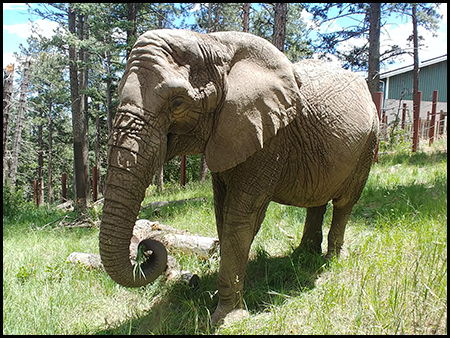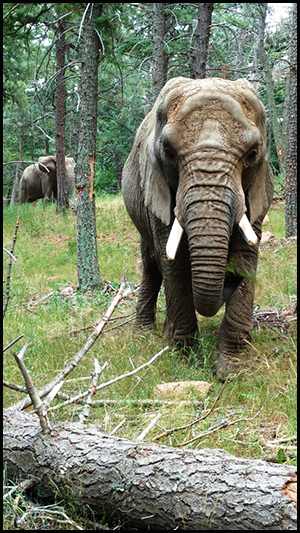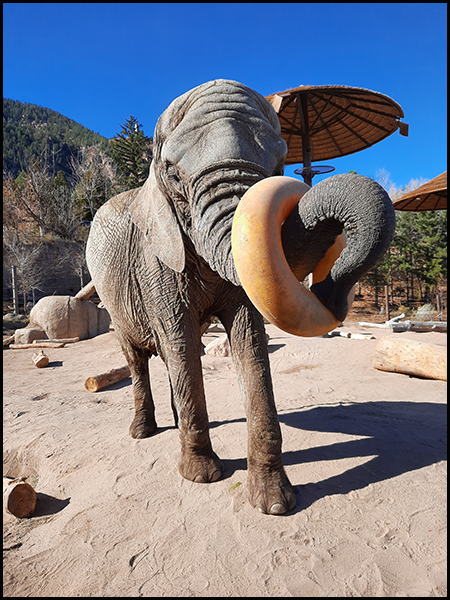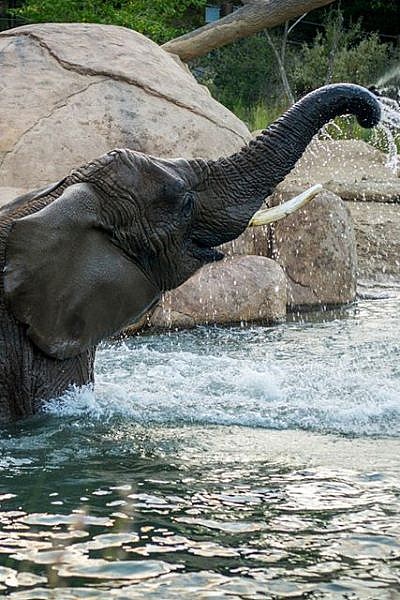One of Cheyenne Mountain Zoo’s most specialized animal areas is the home of our beloved African elephant herd. Jambo (38), Malaika (35), Lucky (41), LouLou (38), Kimba (42) and Missy (51) make up the herd, and each has her own obstacles to face.

Just like humans, the health of each elephant is individual, sometimes regardless of age or environment. Malaika, the youngest of the herd, has experienced perhaps the most life-threatening issues and Missy, the eldest, has been in relatively good health for her age. The elephant care team works to help them comfortably enjoy their golden years, knowing that things change quickly for them and that even our specialized care has its limits.
“There’s quite a range in their ages, and it’s not necessarily true that the older elephants need more specialized care than their younger friends do,” said Jason Bredahl, Encounter Africa animal care manager. “Some have weak limbs, or digestive issues, some have arthritis, some have issues with their feet or tusks, and some have all of the above. We work to proactively lessen the impact of expected age-related issues and try to treat anything else that pops up along the way.”
The Wilgruen Elephant Center has a special crane system that can lift a disabled elephant. Twice those systems have saved Malaika’s life when she stumbled, fell onto her side and couldn’t stand up on her own – an event that can be fatal for elephants. Once in January 2018 and again in April 2019, the team used the barn’s crane system to lift her back onto her feet.
Both of those falls happened without warning, so the team is realistic about it potentially happening again. Although CMZoo has been able to save Malaika twice, it is incredibly lucky that she’s been able to recover both times.
“It really is an honor to work with these girls, because we know we’re supporting them in their third and final act,” said Bredahl. “Their issues are ongoing and can worsen without much warning. For now, they have more good days than bad days. When those bad days inevitably come back around, we’re prepared to care for them and make decisions that are best for them.”

As their issues worsen with age, the team looks for ways to help the girls continue to live their best lives for as long as possible.
An important part of their care routine is rest, but not all elephants lie down to sleep. For Malaika, who doesn’t appear to trust her ability to lie down and get up successfully, the team provides things for her to rest against. In the past, she’s rested with logs, tractor tires or sand piles. Malaika gets her rest by leaning against things to sleep while standing. In the coming weeks, the team will try providing a mostly soil substrate pile for Malaika, to see if she’s more confident leaning against it than the sand piles she’s used previously.
Another important aspect of their ongoing care is encouraging the girls to exercise, explore and play. The elephants can explore their walking path, splash and relax in their pool or spend time in their vacation yard, among other spaces available to them.
“We work to provide environments that keep the herd moving, because just like all of us, a body in motion stays in motion,” said Bredahl. “We also provide enrichment that encourages them to stretch, bend and move throughout every day, and we typically ask the girls to shift every one to two hours into a new space, which keeps them walking and provides new mentally and physically stimulating activities, spaces and enrichment for them to explore.”
There is a space for the elephants that guests can’t see during a visit to the Zoo – a 2-acre field, known as the vacation yard, where the elephants can roam freely in the tall grass, pulling up vegetation, stripping bark from branches and knocking trees over as they please. During the warmer months, it’s not uncommon to find Bredahl sitting in the field on the other side of the fence, watching the ladies relax in a light summer rain.
In addition to the exercise and stimulation the girls get from shifting to new locations, all of the CMZoo elephants participate in daily ‘elephant yoga.’ The routines focus on overall flexibility and strengthening while addressing any problem areas the individuals may have. The elephants are also trained to take voluntary pills and/or injections, when necessary, that help reduce inflammation and pain from arthritis and other ailments.
“It’s a balance, caring for older animals, because we love them and want them to live forever,” said Bredahl. “We work hard to do all we can, proactively, to keep them able and comfortable, but we also know that there comes a point that you recognize that you have done all you can. That’s when we make the hardest, but the most compassionate decisions.”

Guests can get up close to these impressive animal ambassadors every day from March through October, as long as weather permits, at CMZoo’s elephant feeding experiences. From 11 to 11:30 a.m. and 2:30 to 3 p.m., guests can pay $10 to $15 per bundle of produce, and feed an elephant from about four feet away. The Zoo typically contributes $25,000 annually from these feeding experiences to its frontline elephant and rhino conservation partner, Tsavo Trust.
Tsavo Trust is a field-based non-profit organization that uses aerial surveillance and on-the-ground field efforts to protect elephants, rhinos and other wildlife in Tsavo National Park, the largest national park in Kenya. The organization was founded to help protect the last of the big tuskers, which are likely the last viable genetic pool of African elephants with tusks weighing more than 100 pounds each. The park is also home to a number of black rhino sanctuaries established by the Kenya Wildlife Service and supported by the Zoological Society of London.
Just by visiting the Zoo, guests can consider themselves conservation warriors. Through the Quarters for Conservation program, 75¢ of every admission goes to conservation partners, including Tsavo Trust. Small change makes a big difference. Since 2008, those quarters have added up to more than $3 million for conservation, now averaging half a million dollars per year in conservation contributions.

